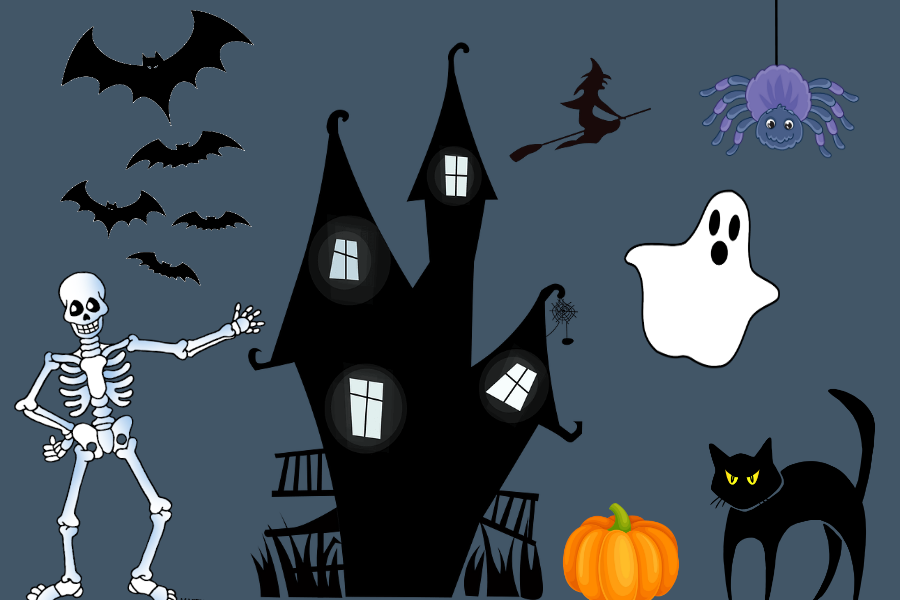Halloween casts its spell: students reflect on beloved spooky traditions
October 30, 2021
For most trick-or-treaters, Halloween is a night of roaming dimly lit neighborhood streets, visiting houses guarded by ghoulish jack-o’-lanterns and stuffing as much candy as possible into one pillowcase. For many Whitman students, however, Halloween represents more.
What defines the spookiest night of the year for some of the community’s resident fright seekers isn’t going from home to home scouring the neighborhood for treats, or even waiting on the other side of the door with candy. Rather, it’s keeping up beloved childhood traditions, whether that means calling for order in a “Candy Court,” or wearing a homemade costume that took weeks to craft.
The bewitching energy of October 31 typically ends after dumping out a swollen bag of candy and eating as much of the stash as one could. For junior Emma Palim, however, bags of M&M’s and Sour Patch Kids scattered across the floor means that Halloween night has only begun.
As a second grade student at Wood Acres Elementary School, Palim and her next door neighbor took their candy collecting duties seriously. Their dedication to the yearly ritual brought them to develop their game “Candy Court” — a ruthless battle for the most coveted treats.
The game was simple: the players would “dump and divide” the treats they collected, and after each of them sorted their candy collection by type, the bartering began. The stakes were high; on the line were desired pieces of candy that were only this readily available once every year.
Although the game usually lasted over an hour, the girls refrained from eating candy during the competition unless they reached an agreement that allowed each of them to consume the same number of pieces. Once the “Candy Court” was adjourned, the two girls enjoyed their candy together and, with wrappers strewn on the floor, it finally felt as if their Halloween night had come to an end.
“It was very formal,” Palim said. “You had to offer a trade and then the other person would consider whether or not it is something they wanted to do. Even though it’s not as serious anymore, it is definitely what I look forward to the most on Halloween.”
Nine years after developing the tradition, Palim and her neighbor play a more relaxed version of Candy Court; instead of trading trick-or-treat candy, they now exchange whatever is leftover in their respective family’s Halloween bowls.
For junior Krishan Kumar, Halloween looks a little different. Each year on one of the spooky days leading up to October 31, Kumar’s family goes to the Potomac Farms pumpkin patch, where they buy four pumpkins — one for each member of the Kumar family. As soon as they get home, the Kumars sit around the kitchen table and hit “play” on an eclectic playlist tailored to each family member’s unique music taste. Then, they carve their pumpkins. Designs range from basic jack-o’-lantern faces to more intricate carvings, like complex depictions of Phineas and Ferb.
After scooping out the pumpkins’ guts with big spoons, Krishan’s mother roasts the pumpkin seeds. Kumar and his older sister spend the next couple hours using the pulp to make homemade pumpkin bread.
“I always look forward to carving the pumpkins because my neighborhood doesn’t get a lot of trick or treaters, so we don’t do a lot of decorations on my house,” Kumar said. “But when we put the pumpkins out on our porch, they’re super noticeable at night because they’re all lit up, so it’s really cool.”
Like Palim and Kumar, sophomores Greta Berglund and Taylor Pyle also cherish keeping up an annual Halloween tradition.
In fifth grade at Burning Tree Elementary School, Berglund and Pyle began designing and then creating handmade Halloween costumes. For the past five years, with almost no parental help, they have transformed themselves into peacocks, puffer-fish, the tootsie roll owls, monsters and candies.
“The hardest costume was probably the peacock,” Berglund said. “We used a piece of cardboard and bought a bunch of peacock feathers to stick on, and then we made a backpack out of it. The most important material is definitely hot glue — a lot of it.”
The duo’s process starts two to four weeks before Halloween. Berglund and Pyle brainstorm ideas, create a list of materials they need, identify the steps to making their costumes and shop for necessary supplies. Then, it’s time to get to work.
Over the past few years, the sophomores’ DIY tradition has expanded to include a larger group of friends.
“Getting more people involved has been really fun,” Pyle said. “The process of hanging out and making the costumes is the best part. Having a cool end result is just a perk.”
Although the days of elementary school costume parades and classroom Halloween parties have long since passed, Kumar said, some childhood traditions are just too meaningful to let go of.
“Halloween gives you the perfect chance to come together and spend time with friends and family,” Kumar said. “Why wouldn’t you want to take advantage of the fun holiday?”










